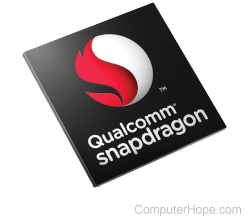eMMC

Short for embedded MultiMediaCard, eMMC is a type of storage organized into a small BGA (ball grid array) and soldered directly to a motherboard. As the name implies, these non-volatile storage devices are not removable, unlike their MMC (MultiMediaCard) counterparts, so repair is more difficult and generally involves replacing the entire unit.
Comprised of flash memory and a controller, eMMC units are found inside many smartphones, tablets, Chromebooks, laptops, wearables, Smart TVs, and other home devices. However, UFS (Universal Flash Storage) has gained control of the market since 2016.
eMMC vs. SSD
When comparing a device with eMMC to a similar device, an SSD (solid-state drive) or NVMe (Non-Volatile Memory Express) drive, eMMC is often slower, smaller, and less expensive to produce. Although these technologies are similar, eMMC is generally associated with devices where cost savings are a priority.
Is eMMC better than SSD?
If you're trying to save money, eMMC is better than SSD. If you need performance (speed) and greater storage capacity, SSD is better.
What is the speed of eMMC?
As of January 2019, with the release of eMMC standard version 5.1A, eMMC has a 250 MB/s read and a 125 MB/s write speed. In comparison, a SATA-based SSD can read/write at 400 MB/s.
Computer acronyms, Laptop, LowerCamelCase, Memory terms, MMC, NVMe, Smartphone, Smart TV, Snapdragon, SSD, Steam Deck, Tablet, UFS, Wearable
